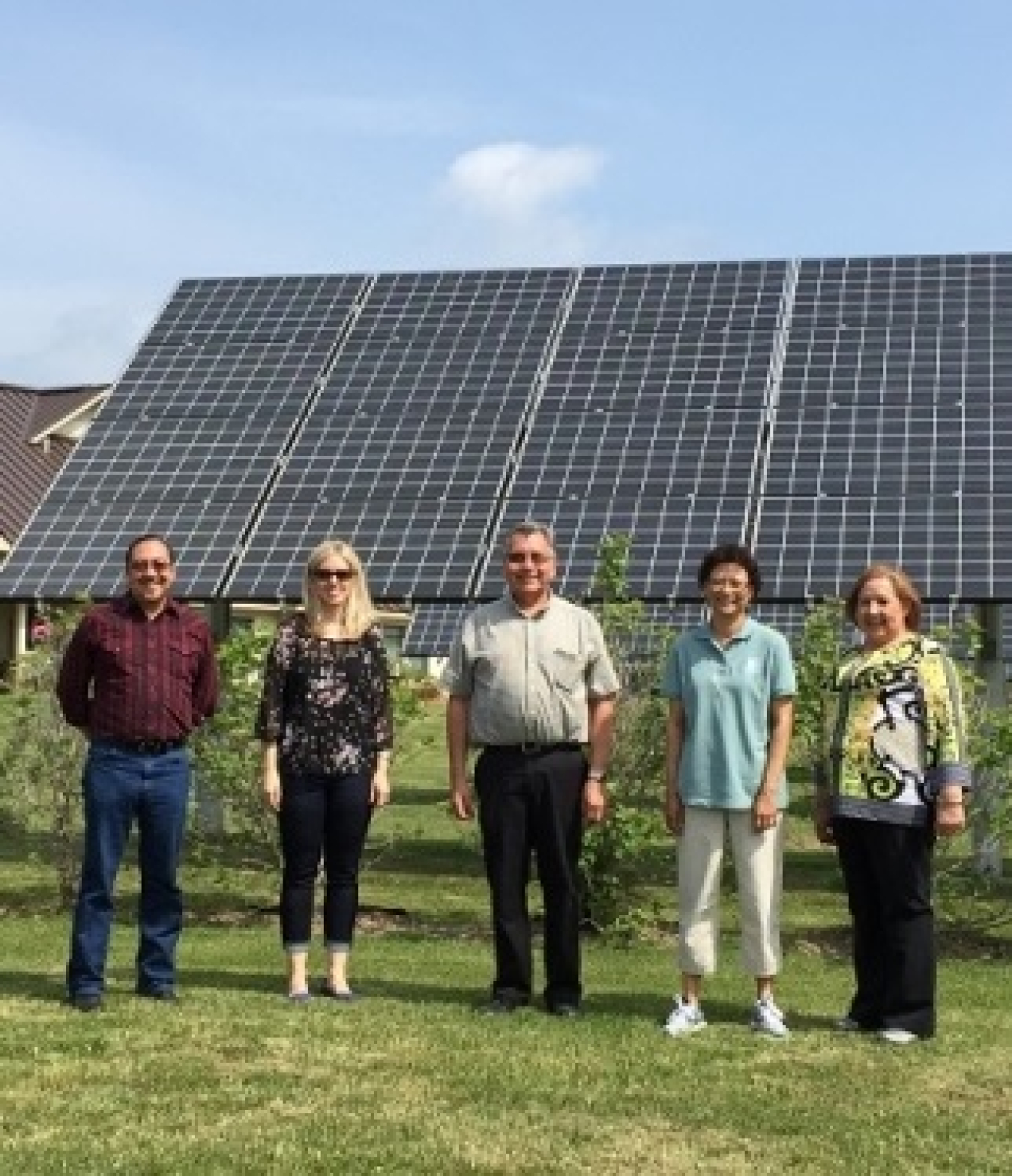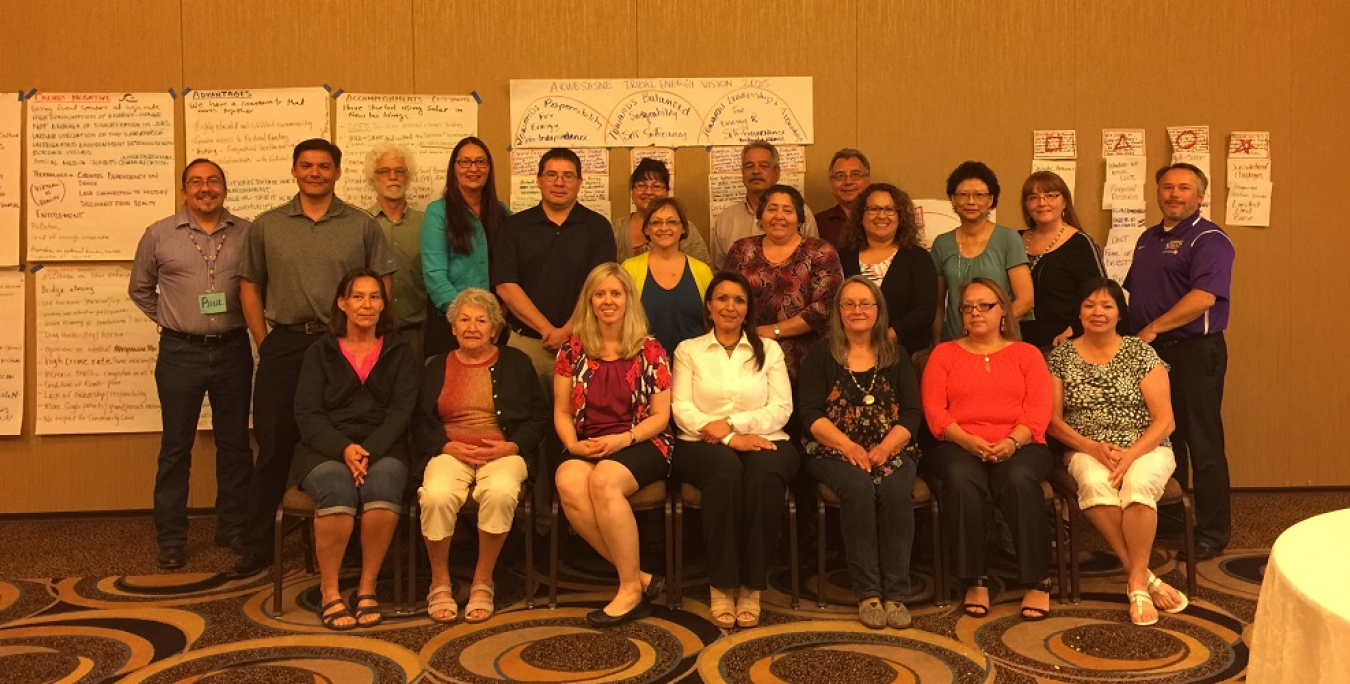
Six photovoltaic arrays generate 32 kilowatts of energy to power 20 units at the Akwesasne Housing Authority’s (AHA) Sunrise Acres housing complex on the St. Regis Mohawk Reservation.
Photo from Lesley Kabotie, Indigenous Collaboration, Inc.
Last week I had the chance to visit the St. Regis Mohawk Tribe, also known by its Mohawk name, Akwesasne. The Mohawk are one of the original Five Nations of the Iroquois, historically based in present-day New York and known as the "Keepers of the Eastern Door." Located in northeast New York along the U.S.-Canadian border, the St. Regis Mohawk Tribe has a diverse membership of more than 10,000 people who live and work on both sides of the border.
The Tribe also has the highest energy costs in the state. In an effort to reduce those costs, improve the lives of community members, and plan for the future, tribal government and department leaders are looking to alternative energy sources to help reduce the Tribe’s reliance on fossil fuels.
The Akwesasne Housing Authority (AHA), with support from tribal leadership, is at the forefront of an effort to pave the way for the Tribe to go green. With a goal of “utilizing all available resources in order to adopt principles and standards for green and sustainability in carrying out its mission,” and under the leadership of Executive Director Retha Herne, AHA applied to receive technical assistance from the U.S. Department of Energy’s (DOE) Office of Indian Energy and Tribal Energy Program with developing a strategic energy plan.

Over the course of three days, more than 40 people attended the St. Regis Mohawk Tribe’s strategic energy planning workshop. Photo by Rachel Sullivan, NREL.
In January 2015, DOE hosted a strategic energy planning session with members from AHA in Florida. While attendees felt the event was beneficial, they realized the effort would be more effective and the likelihood of success greater if more members of the community, including tribal leadership and government representatives, were involved in the planning process. Getting buy-in from tribal leadership and the community early in the process is critical to ensuring the success of energy projects.
AHA applied for and was selected to receive a second round of technical assistance aimed at getting the right people in the room to develop a tribal-wide strategic energy plan, incorporating the initial plan they developed in January. The three-day workshop took place last week and was hugely successful, with more than 40 people attending, including five tribal Chiefs and Sub Chiefs.
As the senior project leader at the National Renewable Energy Laboratory and communications lead for the DOE Office of Indian Energy, I was invited to share information and ideas to assist the Tribe with developing a community stakeholder engagement and outreach plan. I also gave an overview of the many capacity-building resources available to Tribes through the DOE Office of Indian Energy and Tribal Energy Program.
In addition, Sandra Begay-Campbell, a member of the DOE Office of Indian Energy's strategic energy planning team and Tribal Energy Program Lead at Sandia National Laboratories, presented an overview of various technologies that the Tribe has explored—including energy-efficient buildings, solar, biomass, and ground-source heat pumps. Sandra also discussed opportunities for Native youth to pursue through the Tribal Energy Program’s Summer Internship Program.
We also heard from John MacArthur with Beardsley Architects & Engineers on local green building efforts, including the expansion of AHA’s Sunrise Acres in 2011 to include 20 new ultra-efficient homes for low-income seniors.
For the strategic energy planning portion of the workshop, facilitators Lesley and Paul Kabotie of Indigenous Collaboration, Inc. led attendees through an intense journey that moved from recounting the Tribe’s history with energy to identifying goals for energy development to establishing a consensus-based energy vision to developing strategies for achieving that vision. The group then divided into working groups around three areas of focus and developed a timeline for implementation, outlined steps needed to accomplish each strategy, and identified champions for each working group.
According to one tribal leader, it was the first time in his memory that the Tribe has come together as a group collectively to come up with a community oral history. When asked what their key takeaways were from the three-day workshop, one tribal leader said, “Collaboration. Council members from both sides of the border are thinking about the future of our community; not working in silos.” Another attendee said, “Our role is to take care of Mother Earth. This is something we must do.”
On our last day on the St. Regis Mohawk Reservation, we had an opportunity to tour Sunrise Acres, which AHA expanded in July 2011 with grant funding from the U.S. Department of Housing and Urban Development (HUD) and the American Reinvestment and Recovery Act of 2009. The 20 units and a training center are completely powered by renewable energy. Features include:
- 6 photovoltaic arrays that generate 32 kilowatts of energy
- 44 ground-source heat pumps that provide heating and cooling to the buildings
- Solar water heaters
- Insulating concrete forms used in building construction
- Solar tubes for daylighting
- High-efficiency lighting, including LEDs for street lights
- Blown-in cellulose insulation
- Low-e windows
- ENERGY STAR® rated appliances.
When compared to the older housing units in the Sunrise Acres complex, the new buildings are using 60% less energy and saving 51% in energy costs. Community-wide, St. Regis Mohawk Tribe residents are also reducing energy costs by taking advantage of free home energy assessments offered by AHA, the New York State Energy Research and Development Authority (NYSERDA), and the Adirondack North Country Association (ANCA).
ANCA is also working with NYSERDA to implement its Green Jobs – Green New York Program, which provides New Yorkers with access to comprehensive home energy assessments, installation services, and low-cost financing for energy upgrades. Future ultra-efficient building plans for the Tribe include a tribal administration building and additional housing at Sunrise Acres.
The success of the Sunrise Acres project was a significant impetus for the new “Solarize Akwesasne” campaign, which AHA kicked off at a community event I had the opportunity to attend on Wednesday, June 4. Nearly 75 people attended the event to learn about the new solar initiative. Funded through a grant from NYSERDA Community Solar NY under the NY-Sun initiative, and in partnership with ANCA, Solarize Akwesasne will help make solar easier and more affordable for single-family households and area businesses.
The initiative, which will last approximately 6–9 months, works by bringing together groups of customers to install solar systems through one solar installation company that offers competitive, transparent pricing. Residents will also have an opportunity to take advantage of incentives offered by NYSERDA that may cover up to 25% of the total cost of a system. The initiative also has the potential to generate jobs for the local community. Two additional community education events are planned for later this month.
I am inspired by the tenacity with which the St. Regis Mohawk Tribe and AHA are moving to make their community more sustainable and work toward energy independence. And I am grateful to them for involving me in their process. The community is full of movers and shakers who are intent on getting things done. I look forward to watching the community progress toward achieving their energy vision.

